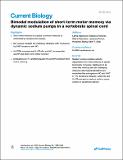Files in this item
Bimodal modulation of short-term motor memory via dynamic sodium pumps in a vertebrate spinal cord
Item metadata
| dc.contributor.author | Hachoumi, Lamia | |
| dc.contributor.author | Rensner, Rebecca | |
| dc.contributor.author | Richmond, Claire | |
| dc.contributor.author | Picton, Laurence | |
| dc.contributor.author | Zhang, HongYan | |
| dc.contributor.author | Sillar, Keith T. | |
| dc.date.accessioned | 2022-05-30T10:30:16Z | |
| dc.date.available | 2022-05-30T10:30:16Z | |
| dc.date.issued | 2022-03-14 | |
| dc.identifier | 277419127 | |
| dc.identifier | f0f73d1f-1094-4bb0-aa79-9231ff10fe04 | |
| dc.identifier | 85125937260 | |
| dc.identifier | 000779588200009 | |
| dc.identifier.citation | Hachoumi , L , Rensner , R , Richmond , C , Picton , L , Zhang , H & Sillar , K T 2022 , ' Bimodal modulation of short-term motor memory via dynamic sodium pumps in a vertebrate spinal cord ' , Current Biology , vol. 32 , no. 5 , pp. 1038-1048.e2 . https://doi.org/10.1016/j.cub.2022.01.012 | en |
| dc.identifier.issn | 0960-9822 | |
| dc.identifier.other | ORCID: /0000-0003-0171-3814/work/107718152 | |
| dc.identifier.other | ORCID: /0000-0002-9941-4494/work/107718370 | |
| dc.identifier.uri | https://hdl.handle.net/10023/25462 | |
| dc.description | Authors are grateful for the financial support of this research by the University of St Andrews, the E&RS Neuroscience research fund and BBSRC grant BB/T015705/1. | en |
| dc.description.abstract | Dynamic neuronal Na+/K+ pumps normally only respond to intense action potential firing owing to their low affinity for intracellular Na+. Recruitment of these Na+ pumps produces a post-activity ultraslow afterhyperpolarization (usAHP) up to ∼10 mV in amplitude and ∼60 s in duration, which influences neuronal properties and future network output. In spinal motor networks, the usAHP underlies short-term motor memory (STMM), reducing the intensity and duration of locomotor network output in a manner dependent on the interval between locomotor bouts. In contrast to tonically active Na+ pumps that help set and maintain the resting membrane potential, dynamic Na+ pumps are selectively antagonized by low concentrations of ouabain, which, we show, blocks both the usAHP and STMM. We examined whether dynamic Na+ pumps and STMM can be influenced by neuromodulators, focusing on 5-HT and nitric oxide. Bath-applied 5-HT alone had no significant effect on the usAHP or STMM. However, this is due to the simultaneous activation of two distinct 5-HT receptor subtypes (5-HT7 and 5-HT2a) that have opposing facilitatory and suppressive influences, respectively, on these two features of the locomotor system. Nitric oxide modulation exerts a potent inhibitory effect that can completely block the usAHP and erase STMM. Using selective blockers of 5-HT7 and 5-HT2a receptors and a nitric oxide scavenger, PTIO, we further provide evidence that the two modulators constitute an endogenous control system that determines how the spinal network self-regulates the intensity of locomotor output in light of recent past experience. | |
| dc.format.extent | 2493219 | |
| dc.language.iso | eng | |
| dc.relation.ispartof | Current Biology | en |
| dc.subject | Na+/K+ pump | en |
| dc.subject | Neuromodulation | en |
| dc.subject | Afterhyperpolarisation | en |
| dc.subject | Short-term memory | en |
| dc.subject | Motor control | en |
| dc.subject | Xenopus | en |
| dc.subject | Swimming | en |
| dc.subject | Locomotion | en |
| dc.subject | Spinal cord | en |
| dc.subject | CPG | en |
| dc.subject | QH301 Biology | en |
| dc.subject | RC0321 Neuroscience. Biological psychiatry. Neuropsychiatry | en |
| dc.subject | NDAS | en |
| dc.subject.lcc | QH301 | en |
| dc.subject.lcc | RC0321 | en |
| dc.title | Bimodal modulation of short-term motor memory via dynamic sodium pumps in a vertebrate spinal cord | en |
| dc.type | Journal article | en |
| dc.contributor.sponsor | BBSRC | en |
| dc.contributor.institution | University of St Andrews. School of Psychology and Neuroscience | en |
| dc.contributor.institution | University of St Andrews. Institute of Behavioural and Neural Sciences | en |
| dc.identifier.doi | https://doi.org/10.1016/j.cub.2022.01.012 | |
| dc.description.status | Peer reviewed | en |
| dc.identifier.url | https://www.sciencedirect.com/science/article/pii/S0960982222000239#app2 | en |
| dc.identifier.grantnumber | BB/T015705/1 | en |
This item appears in the following Collection(s)
Items in the St Andrews Research Repository are protected by copyright, with all rights reserved, unless otherwise indicated.

